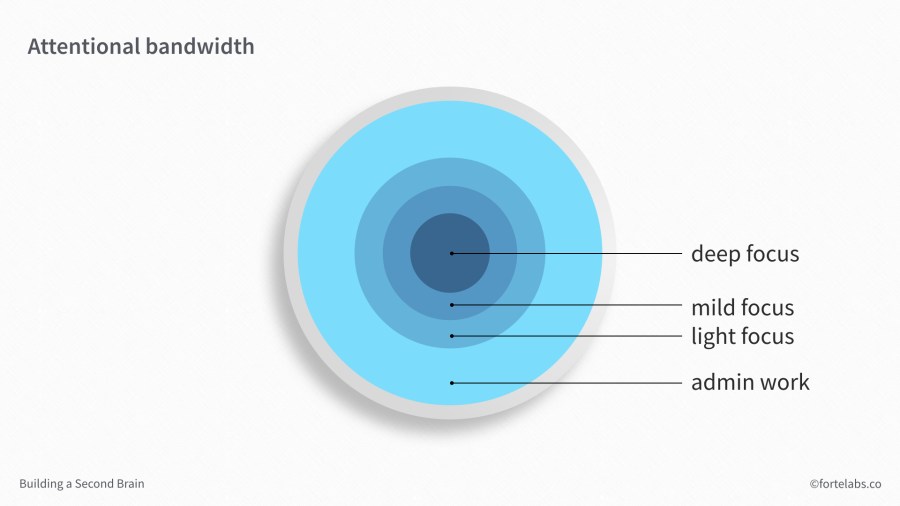
In Part 15, I advocated for multithreading, or weaving together multiple projects to take advantage of unexpected opportunities and synergies.
To take advantage of the benefits of multithreading, it’s critical that you begin to think of yourself not as a lone project manager, but as a project portfolio manager (PPM). Traditionally found only in large companies with hundreds of simultaneous projects, digital technology has made it possible and necessary for each of us to manage a portfolio.
The two most important skills you’ll need as a PPM are:
- Choosing the right projects to start (good inputs)
- Maximizing project completions (good outputs)
To accomplish these, we’ll need to refine our understanding of Return on Attention (ROA), first introduced in Part 1.
When determining the return on our attention, our natural inclination is to focus on throughput, which is how many projects actually get completed.
If Minaal takes on 10 projects, but only finishes 5, she has a throughput of 50%. Nitai might take on only 3 projects, but finish 2 of them, resulting in a higher throughput of 66%. Most people correctly sense that it is project completions that matter, and often will resist starting new ones until their current ones finish.
But now let’s add an important wrinkle. It is not throughput that matters so much as throughput per constraint unit. If you remember from Part 2, unlike units of time or money, not all units of attention are created equal. You might have an average “attention budget” each week of:
- 6 hours of deep focus
- 8 hours of mild focus
- 10 hours of light focus
- 22 hours of administrative work
With this budget, the constraint is clearly deep focus, and a constraint unit (CU) would be one hour of deep focus time (a CU is equivalent to a “flow cycle,” discussed in Part 3).
Imagine I propose two projects to you with the following returns:
- Project A: 3 hours per week for 4 weeks, with a return of $1,000
- Project B: 3 hours per week for 4 weeks, with a return of $2,000
Project B is the obvious choice, since it offers double the ROA of Project A.
But what if I told you that Project B will require 3 hours of deep focus (50% of your deep focus budget), whereas Project A will require 3 hours of administrative work (only 14% of your budget)?
Then the choice is reversed. When you take into account that your constraint is deep focus, Project A has a much better return. Taking into consideration the number of constraint units needed is so important, you might be more willing to take on a project that demands 10 hours of administrative work than one that requires even 1 hour of deep focus.
In other words, the effective ROA (or eROA) of a given project is a function of the kind of attention it requires, not just the amount.
When most people consider taking on new projects, they think of projects that require their scarcest forms of attention. This is natural – this is when they produce their best work. But then they look at their schedules, with barely enough time to do the work they’ve already committed to, and they give up, thinking they have “no bandwidth.”
But as we’ve discussed, your attentional bandwidth is not of a single kind; it can be thought of as layers. Imagine looking straight down the “pipe” of your personal bandwidth (which isn’t a pipe, but let’s use the usual metaphor for simplicity):
The core of your bandwidth, the deep focus, is the scarcest variety of attention, because it is so difficult and expensive to get into that state of flow (as discussed in detail in Part 2).
But the other kinds of attention are also valuable, while much less scarce. If you can find a way to make progress on projects without deep focus, by moving quickly and touching lightly instead of heavy lifting, you will find there is lots of available attention.
Look at the rise of smartphones and the more than 4 hours per day we spend tapping away at various apps – who would’ve thought we all had that much time available, until a device came along that allowed us to make use of all those little pockets of time throughout our day?
With this more sophisticated model in mind, we have a wide range of options for executing on the first objective of a project portfolio manager:
Choosing the right projects to start (good inputs):
- We can use our CUs on projects that expand how many CUs we have available, such as establishing a repeatable process
- We can prioritize projects that take CUs to build, but not to maintain, like an online business that, once established, brings in passive revenue
- We can kill projects or commitments that consume a disproportionate number of CUs for the return they produce
- We can use our mild and light focus times specifically to take on projects that improve the quality of our CUs, such as meal planning or exercising
- We can collaborate with others who have different skills, trading our light focus time for their deep focus time (and returning the favor when the opportunity arises)
We’ll address the second objective, maximizing project completions (good outputs), in upcoming articles.
For now, it’s important to understand that your CUs are fundamentally limited, not just by your environment and circumstances, but by your biology and social needs. You may be able to create some extra hours of focus time in a given week or month, but it averages out to a steady pace over the long term.
That’s why it’s essential to take full advantage of the CUs you have, by spending every possible minute of deep focus on the most unique and valuable work you can possibly do.
Follow us for updates on Twitter, Facebook, Instagram, LinkedIn, or YouTube.
The Only Subscription
You Need to
Stay at the
Edge of AI
The essential toolkit for those shaping the future
"This might be the best value you
can get from an AI subscription."
- Jay S.
Join 100,000+ leaders, builders, and innovators

Email address
Already have an account? Sign in
What is included in a subscription?
Daily insights from AI pioneers + early access to powerful AI tools








Comments
Don't have an account? Sign up!